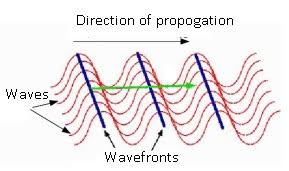Waves
Waves
Waves transfer energy and information without transferring matter.
The wavefront is the front of the wave, or the same point on each wave. Generally speaking this tends to be the crest or peak of the wave.
The period of a wave is how long it takes for one wave to go past a certain point.
Evidence of Waves
Evidence of waves can be found all over nature but we shall have a look at two specific common examples with water and air.
- If an object, like a ball, is placed on the surface of a pond when ripples move across it, the ball will move up and down but __not outwards __with the wave. This can be seen in any pool of water and even the sea!
- Similarly, when sound waves move through the air to a person’s ear, the air itself does not move - instead the sound is transferred through vibrating molecules, which stay where they are and vibrate about a fixed point. Our eardrums vibrate with the molecules.
Different Waves
There are two different types of waves, transverse and__ longitudinal.__ You need to make sure you can accurately draw and label each wave.
Transverse Waves: you need to learn this definition! Choose one which is easier and never forget it
A transverse wave is a wave that oscillates perpendicular to its propagation
OR
A wave that vibrates at right angles to the direction of energy transfer.
A transverse wave looks like this: Don’t forget to always include the labels!
Don’t forget to always include the labels!
The amplitude is the height of the wave from the rest point or the point of equilibrium. The peak is the top of the wave and the trough is the bottom.
Examples include ripples on a water surface, an electromagnetic wave (light) and the s-wave of a seismic wave.
Longitudinal Waves: you need to learn this definition! Choose one which is easier and never forget it
A longitudinal wave is a wave that oscillates parallel to its propagation
OR
A wave that vibrates parallel to the direction of energy transfer. Don’t forget to always include the labels!
Don’t forget to always include the labels!
An example of this wave is a sound wave and the p-wave of a seismic wave.
- What is a transverse wave?
- Your answer should include: oscillates perpendicular to its propagation / vibrates at right angles to the direction of energy transfer
Explanation: A transverse wave is a wave that oscillates perpendicular to its propagation OR A wave that vibrates at right angles to the direction of energy transfer. - What is a longitudinal wave?
- Your answer should include: oscillates parallel to its propagation / vibrates parallel to the direction of energy transfer
Explanation: A longitudinal wave is a wave that oscillates parallel to its propagation OR A wave that vibrates parallel to the direction of energy transfer. - Is a p-wave a transverse or longitudinal wave?
- longitudinal
